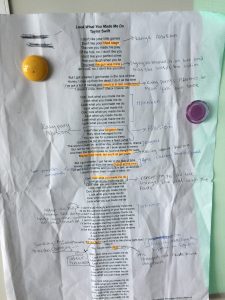 Yesterday, my grade 9’s had the opportunity to attend a presentation by Steve Dawson, a Fox Sports anchor and sports biographer. I wasn’t quite sure what he would discuss during his presentation, and to be honest, I thought he would focus mostly on sports and athletes. Thankfully, I was wrong.
Yesterday, my grade 9’s had the opportunity to attend a presentation by Steve Dawson, a Fox Sports anchor and sports biographer. I wasn’t quite sure what he would discuss during his presentation, and to be honest, I thought he would focus mostly on sports and athletes. Thankfully, I was wrong.
Dawson’s main focus was how to approach an interview with a potential interviewee. This may seem like something that our grade 9’s don’t have to worry about now (if ever), but as I thought about their future classes, I began to realise that what Dawson presented to them was actually a good life skill to learn.
Dawson had 5 main tips for approaching an interview, but the two that resonated with me the most are as follows:
– ask open-ended questions
– listen to the answer
As an English teacher, part of my job is to ensure that students are expressing themselves well, both in verbal and written form. If I ask a closed-ended question (e.g. “Did you enjoy reading The Handmaid’s Tale?”) then the answer could be either yes or no. If, however, I ask the same question but in an open-ended fashion (e.g. “In what ways did Offred make you consider the absence of women’s rights in Gilead?”) I will hopefully receive a more thoughtful response.
Of course, as our students answer our questions, it is also important for us to listen. We need to be mindful of what they say and acknowledge how it contributes to our discussion as a whole. No more thinking about our own to-do list … we must be present–mentally–when our students are responding to our questions.
 Last night I was going through my Twitter feed before bed and I came across this blog post by Richard Branson. In it, he talks about how “positivity breeds positivity,” something that really resonated with me. I started thinking about how I can re-word my open-ended questions in order receive responses that are positive in nature. If a student writes an essay replete with errors, for example, I can either ask why s/he has made so many mistakes, or I can ask her/him how I can help to improve on their future essays. One will potentially garner a negative response, whereas the other will focus on a more positive outlook.
Last night I was going through my Twitter feed before bed and I came across this blog post by Richard Branson. In it, he talks about how “positivity breeds positivity,” something that really resonated with me. I started thinking about how I can re-word my open-ended questions in order receive responses that are positive in nature. If a student writes an essay replete with errors, for example, I can either ask why s/he has made so many mistakes, or I can ask her/him how I can help to improve on their future essays. One will potentially garner a negative response, whereas the other will focus on a more positive outlook.
See the difference?
There is much value in our Writers’ Fortnight workshops. I hope our students see the value in them, too.



